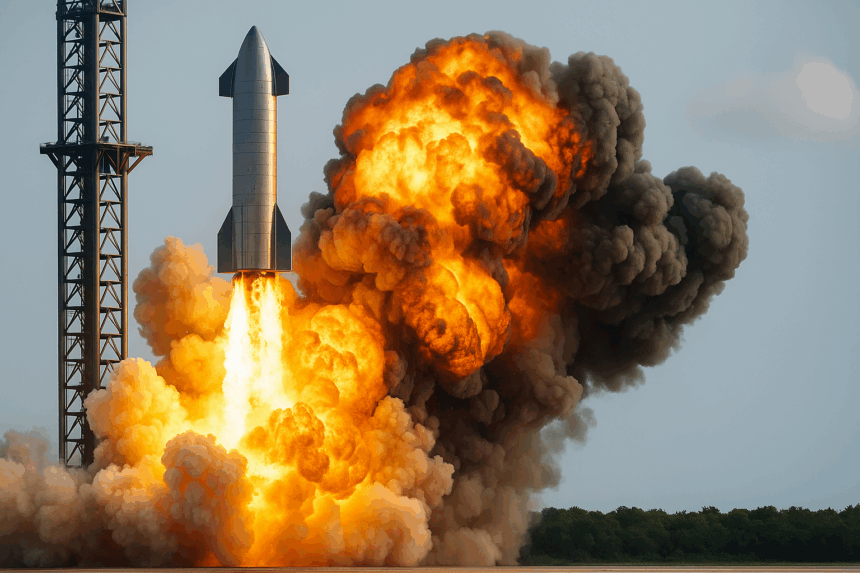SpaceX experiences another setback as its Starship heavy rocket explodes on the test stand during fueling. The explosion happened just before the planned static fire test for the rocket’s upper stage. This latest incident adds pressure on SpaceX’s efforts to develop a fully reusable launch system for missions to the Moon, Mars, and beyond.
What’s Happening & Why This Matters
At 11:02 p.m. Central Time, SpaceX’s Starship exploded while fueling its upper stage on a test stand at the company’s Starbase facility in Texas near the U.S.-Mexico border. The test was a precursor to a static fire, where all six Raptor engines would ignite while the rocket remained on the ground.
The explosion triggered secondary blasts that sent debris high into the air, engulfing the test stand in flames. Fortunately, SpaceX confirmed no injuries among its personnel and maintained a safety perimeter during the operation.
CEO Elon Musk later explained the probable cause: a failure of a nitrogen composite overwrapped pressure vessel (COPV) in the payload bay. This type of pressure vessel has failed in past SpaceX rockets, including a 2016 Falcon 9 explosion caused by a helium COPV buckling under pressure.
The COPV failure marked a new type of malfunction for this vessel design, raising fresh concerns about Starship’s reliability. SpaceX previously improved its COPV designs after the 2016 incident, making Falcon 9 one of the most dependable rockets.
The Starship is far larger and more complex than the Falcon 9. At 404 feet tall, Starship aims for full reusability of both stages and the capacity to carry heavy payloads to the Moon and Mars with orbital refueling between stages.
However, the upper stage of Starship has faced repeated failures. This explosion follows four catastrophic upper-stage failures in a row, including last month’s failed flight, where the upper stage spun out of control after engine cutoff and broke up on reentry.
These setbacks threaten SpaceX’s plans to scale up Starlink satellite launches by carrying dozens of “v3” satellites per flight. They also put NASA’s contract for Starship to serve as the crewed lunar lander for the Artemis Moon missions at risk. NASA awarded SpaceX $2.89 billion in 2021 for this project, which requires several test flights to prove Starship’s safety and refueling capabilities.
NASA’s alternative lunar lander, Blue Origin’s New Glenn rocket, also faces delays, having flown only once. The incoming NASA administrator will inherit these challenges after President Trump unexpectedly withdrew Musk-backed nominee Jared Isaacman.
Despite failures, SpaceX remains a leading space innovator. The company completed Falcon 9’s 75th launch in July 2023, delivering more Starlink satellites and surpassing the total orbital Starlink count of 9,000.
TF Summary: What’s Next
SpaceX’s Starship explosion during fueling presents the technical risks associated with developing next-generation reusable rockets. Continued testing and redesigns are necessary to meet ambitious Moon and Mars mission goals.
The Starship’s future impacts NASA’s Artemis lunar plans and the scaling of Starlink internet service. The aerospace market and Musk-o-vites will closely follow SpaceX’s steps to address their critical challenges.
— Text-to-Speech (TTS) provided by gspeech



